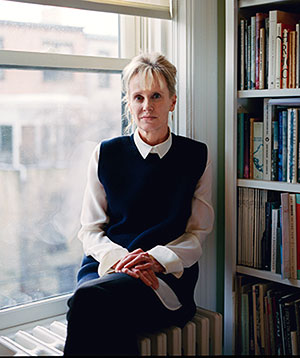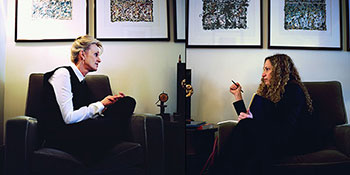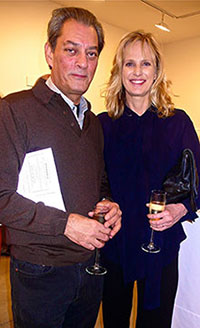Siri Hustvedt: ‘It was really fun writing as an enraged person’

Roula Khalaf, Editor of the FT, selects her favourite stories in this weekly newsletter.
Long before I climb the front steps of Siri Hustvedt’s Brooklyn brownstone, I have told nearly everyone I love – and some random acquaintances – to stop whatever they are doing and read her new novel, The Blazing World. I have been carrying the book around with me on trains, in hotels, through the city’s sadistically frigid days, and it has created a secret warm universe so, as you can imagine, I am very excited to meet its maker.
When she comes to the door, Hustvedt is elegant in a Virginia Woolf way: astonishingly tall and thin, in a white silk shirt and black sweater vest. Her blonde hair is swept up in a bun, and she is startlingly beautiful. It is the day before her 59th birthday.
She comes from Northfield, a small town in Minnesota. Her parents are Norwegian – her father from an immigrant family, and her mother migrating as an adult – and Hustvedt comes across as faintly European, especially in her intellectual style. She has been married to the novelist Paul Auster for more than three decades, and they have a 26-year-old daughter, Sophie.
We perch in her sitting room to discuss the new novel. The Blazing World is the playful, ebullient, brainy story of Harriet “Harry” Burden, an artist in her early sixties. She is too big in every way, overflowing with ideas, with personality, with erudition; she is practically a giantess, big-boned, troublingly voluptuous, thickening in the middle, with wild, curly hair. Her work has been ignored, or condescended to, and she devises an experiment, called “Maskings”, where she will show her new work through a series of three younger male artists; the experiment leads her into a sinister pas de deux with the last of the three men, and into very unsettling emotional territory.
The story is told in fragments, pieced together from Harry’s unfettered notebook entries; the accounts of her children; her best friend from childhood, a dopey but warm New Age girl named Sweet Autumn; condescending scholars; sharply sarcastic newspaper writers; and the young artists who were her “masks”, among many others.
When we talk about the book’s beguiling central premise – will the world respond differently to a work of art if they think a handsome young male artist has created it? – Hustvedt reads aloud a passage from Harry’s notebooks: “All intellectual and artistic endeavours, even jokes, ironies, and parodies fare better in the mind of the crowd when the crowd knows that somewhere behind the great work or the great spoof it can locate a cock and a pair of balls.”
Hustvedt says: “The central question is what happens when a woman’s work is masked by a man. The result is very complicated. The book is not agitprop.” The book is clearly a feminist undertaking but joyously, unpredictably so. Hustvedt eschews all feminist cliché. She throws herself into rich ambiguities. Her artist is not, for instance, oppressed or held back by domestic life. Harry loved her husband even after she found out he cheated on her. She loved taking care of her children.
“Having children is one of the most passionate and involving bits of business in human life,” Hustvedt says. And while we are talking Sophie wanders down to the kitchen in a hoodie, having come home with a case of strep throat.
“I wanted to make it clear,” Hustvedt says, “that, in some way, Harry had also held herself back.”
As we talk more about the novel, Hustvedt speculates about her characters as if they are real people. Talking about Rachel Briefman, a psychoanalyst who is Harry’s best friend from childhood, she says: “She can see into Harry’s foibles. But they really love each other, those two,” and I begin to feel like the two characters are sitting in the next room having tea.
Hustvedt’s novels – What I Loved, The Enchantment of Lily Dahl, The Summer Without Men, among others – have always been smart, accomplished, critically acclaimed but this one feels like a departure. There is more heat in it, more wildness; it seems to burst on to a whole other level of achievement and grace.
“I think in some way this may be the freest book I have ever written,” she says. “I had a lot of fun writing it. The pleasure was immense but there is no question in my mind that this is a large book for me. I put everything I had into it.”
I wonder what changed or unloosed in her; what has given her the power to break out, the sudden dazzling outpouring of this book? She tells me that she is at the freest point in her life, but why? “Is it menopause or is it psychoanalysis? Could be either. Could be both.” She is joking but she is not joking. The quicksilver of her irony is hard to chase through conversation. The question – how did she come into her own as an artist? How did Harriet Burden come into her own as an artist? How do women break free of inhibitions, of the reassuring, civilised worlds they have created, the elegant living rooms and feverish children – is unanswerable.
Glancing around the chicly impeccable house, where there is not a trace of clutter even in the kitchen, with its sleek blue wood cabinets – not a bottle of olive oil, a half-opened box of cookies – it is hard to imagine this as the birthplace of Harriet Burden. Harry with her tumult, her explosive passions, her uncontrolled effusion, seems very unlike Hustvedt, at least that part of her one immediately intuits. In conversation Hustvedt seems cool, cerebral, consummately controlled. There is even in her appearance a conspicuous perfectionism, a high-minded glamour, a serious elegance that is the very antithesis of Harry, who is so charismatically all over the place. But Harry is clearly, as Hustvedt puts it, “an outpouring from regions of myself”.

“It was really fun writing as an enraged person,” Hustvedt says. Unlike the bitterness or sourness of certain feminist voices, Harry’s anger is pure energy. Her rage is magnetic.
“Rage has such focus,” Hustvedt says. “It can’t go on for ever but it’s invigorating. There is no question that I have an underground Harry. The explosiveness of Harry is very appealing to me. It’s the opposite of control. And when I am writing, that explosive freedom is there.”
Intellectually, Hustvedt is an omnivore, immersed in philosophy, neuroscience, conversant in conflicting academic fields. She has a PhD in literature from Columbia University, where she wrote her dissertation on Dickens, but she also reads compulsively in a variety of disciplines. Her essays range through philosophy, literature, psychoanalysis and science. She casually mentions giving a lecture at a “neurophysiology conference” and giving the keynote address at an international congress of Kierkegaard scholars celebrating the 200th anniversary of the philosopher’s birth.
“I’m afraid the novel is a little dense with ideas,” Hustvedt says.
“But it’s also so much fun to read,” I say. “That’s pretty rare. A novel of ideas that is also fun.”
“That’s what I was hoping for,” she says. “But you never know.”
…

One of the great themes of the novel is how difficult it is for a woman artist to come to terms with her own ambitions, the daunting scope of her artistic desire, to free herself from the constraints of niceness or modesty. Hustvedt talks about the idea of “adaptive grandiosity”, which is the idea of an artist needing to withstand the inevitable buffeting and criticism of the world. That adaptive grandiosity, of course, comes much easier to men than women. As Hustvedt puts it: “The ability to embrace a position that seems arrogant or high minded or large is often difficult for women.” But in The Blazing World she herself seems to have overcome that difficulty and the largeness is exhilarating – the unfettered release of intellectual energy, the complete lack of fear buoys the novel.
She says: “I remember when I was at college and I was reading one of these hugely learned figures like Cassirer or Panofsky, and I walked out of the library and I thought to myself I’ll never be able to do that, to synthesise all of these different fields, to have that mastery. And then, sometime in my late forties, after reading and reading and reading, I thought: I can do it now. And the way I thought of it is: I can dance, I can dance.”
I wonder politely if some of her readers may miss the Kierkegaard references, may not be able to grasp some of the highbrow puns. It seems to me that stuff is not essential for the enjoyment of the book or even a semi-decent intelligent apprehension of it but who is her ideal reader? “I remember hearing how Nabokov once said he realised that his ideal reader was all these little Nabokovs.” She laughs. “It was such a startling thought. I thought to myself, oh god, Siri. Maybe your ideal readers are these little Siris who get all your jokes and puns.” Will anyone else care about Harriet Burden’s struggle to create art, in other words? But it seems clear, as we sit on the celery velvet chairs, with great drifts of snow outside, that the book will blaze through the world.
‘The Blazing World’ is published by Sceptre on March 13, £18.99 (hardback). Katie Roiphe is a professor at New York University. Her latest book is ‘In Praise of Messy Lives’ (Canongate, £12.99). To comment, email magazineletters@ft.com
To comment on this article please post below, or email magazineletters@ft.com
Comments